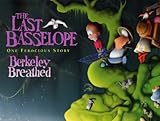
By Berkeley Breathed
(Scholastic, 1992)
As children (and adults), we are afraid of things we can’t see, things with horrible reputations: the bogeyman; the hermit three doors down with sharp pruners and a lawn littered with “Keep off the Grass” signs; and, as Berkeley Breathed reminds us, the “razor-horned, slobbery-fanged beast” known as the Last Basselope.
Don’t remember tales of the Last Basselope? Oh, we humans are skilled at repressing that which we cannot handle. Breathed gets us up to speed, explaining that basselopes—yes, think Basset hound/antelope—date back to dinosaur days, where their presence caused “ripsnorting dinosaur pandemonium” among the lesser beasts. (And they were all lesser beasts.)
Now only one basselope remains. Opus, Breathed’s beloved penguin from Bloom County days, fancying himself as a Great and Famous Discoverer, decides to lead an expedition to find the elusive creature. He is joined, reluctantly, by his TV-addicted cohorts, Bill the Housecat, Milquetoast the Housebug and Ronald-Ann the Housekid.
As with the Abominable Snowman, the Grinch and the Cowardly Lion, the Last Basselope is woefully misunderstood, but not everyone is interested in correcting the hype.
Opus is a lovably goofy character who instantly captivates here. (No wonder Breathed continued to develop storylines around the penguin in the comics Outland and Opus.) While the text per page is more than current picture books, each sentence adds an extra layer of humor and characterization to the story. The illustrations are perfect complements that will cause the reader/listener to go back and forth from words to pictures. As the troop sets off, Bill the Housecat must lug a load that includes hefty boxes of gummy bears and marshmallows as well as a container labeled “Moose-Off”. A reference to Opus falling asleep with “a deadly weapon at the ready” is depicted by the penguin gripping the edge of his blanket while grasping a fly swatter.
There are deeper messages in this book about endangered species, newshounds and children’s reluctance to explore the outdoors, but the story comes first—and it’s an amusing, whimsical tale that carries on in the tradition of A.A. Milne.
(Scholastic, 1992)
As children (and adults), we are afraid of things we can’t see, things with horrible reputations: the bogeyman; the hermit three doors down with sharp pruners and a lawn littered with “Keep off the Grass” signs; and, as Berkeley Breathed reminds us, the “razor-horned, slobbery-fanged beast” known as the Last Basselope.
Don’t remember tales of the Last Basselope? Oh, we humans are skilled at repressing that which we cannot handle. Breathed gets us up to speed, explaining that basselopes—yes, think Basset hound/antelope—date back to dinosaur days, where their presence caused “ripsnorting dinosaur pandemonium” among the lesser beasts. (And they were all lesser beasts.)
Now only one basselope remains. Opus, Breathed’s beloved penguin from Bloom County days, fancying himself as a Great and Famous Discoverer, decides to lead an expedition to find the elusive creature. He is joined, reluctantly, by his TV-addicted cohorts, Bill the Housecat, Milquetoast the Housebug and Ronald-Ann the Housekid.
As with the Abominable Snowman, the Grinch and the Cowardly Lion, the Last Basselope is woefully misunderstood, but not everyone is interested in correcting the hype.
Opus is a lovably goofy character who instantly captivates here. (No wonder Breathed continued to develop storylines around the penguin in the comics Outland and Opus.) While the text per page is more than current picture books, each sentence adds an extra layer of humor and characterization to the story. The illustrations are perfect complements that will cause the reader/listener to go back and forth from words to pictures. As the troop sets off, Bill the Housecat must lug a load that includes hefty boxes of gummy bears and marshmallows as well as a container labeled “Moose-Off”. A reference to Opus falling asleep with “a deadly weapon at the ready” is depicted by the penguin gripping the edge of his blanket while grasping a fly swatter.
There are deeper messages in this book about endangered species, newshounds and children’s reluctance to explore the outdoors, but the story comes first—and it’s an amusing, whimsical tale that carries on in the tradition of A.A. Milne.
No comments:
Post a Comment